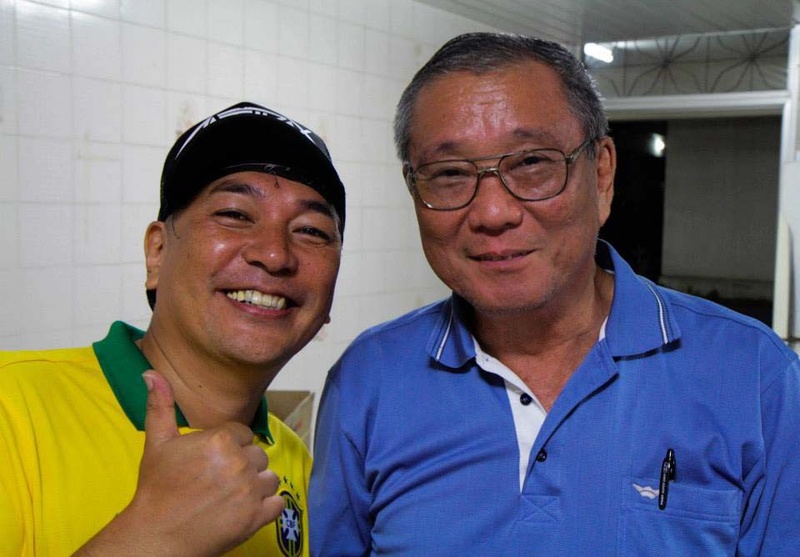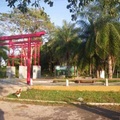"It was probably from 1960 to 1964. My father and my brothers were selling vegetables. I was about 13 or 14 years old then. I sometimes helped out. At that time we sold radishes, cabbages, and cucumbers. Our friends from Sales (immigrants and Japanese people in Manaus call the Efegenio Sales settlement Sales) also sold bitter melon, calling it 'niga gori' when selling it to Brazilians who had no idea what it was."
"Hahaha. Back then, there weren't any nice roads like there are now, right? How did you manage to travel 40 kilometers to Centro (the city center) to sell your goods?"
"It was a truck. They would go out to sell vegetables once or twice a week, and the Thurles guys would get up at around 3am and get ready to bring the vegetables to the town. The road wasn't paved so it took over an hour to get from Thurles to Centro. They would start selling vegetables from around 5am."
As he drives his Toyota Corolla through the crowded streets of Manaus, Mr. Kiba keeps talking. After helping with farming in Saales, Mr. Kiba has run a flower shop, a restaurant, and a karaoke shop, and even worked as an interpreter and travel guide, so his storytelling skills are second to none.
"On the other hand, the city hall shopping truck would come to pick me up twice a week and take me to town to buy farinha (powdered mandioca potato), beans, rice, and vegetables. At that time there weren't many types of vegetables, just macaxeira (a Brazilian potato that's delicious fried!), pumpkin, local lumpy tomatoes, and huge Brazilian eggplants. That's right, it must have been a little after that.
When I was 18, I saw a Takakura Ken movie. I was happy to see Japanese movies. I watched movies like "Abarenbo Shogun," "Zatoichi," and "Otoko wa Tsurai yo." We would get together as a youth group and go to see movies in a truck with 30 or 40 people. Movies from Japan only came occasionally, so the cinema was filled with Japanese people. It was one of the few things I had to enjoy."
"There must have been language problems, too," he said. The immigrants who now speak fluent Portuguese faced great difficulties when they first settled in the country.
"That's right. When I was doing farm work, I couldn't communicate with the laborers because we couldn't communicate with each other. I had to use gestures and show them by myself. When I first came here, I didn't understand the language at all. I studied Portuguese at a school attended by local Brazilians, but it was difficult. Truck drivers and others would teach me all sorts of things, but they only taught bad words (palavrão) for fun. I wanted to know the meaning, so I asked a female teacher at the school I was attending, but she got really angry and said, "Never use that word again!" In the end, there was no explanation, so it must have been a really bad word. The teacher was pretty, so I was embarrassed."
As they continued to sell without giving up, their reputation grew, and the vegetables grown by Japanese farmers won acceptance and are now an indispensable part of the Brazilian diet. Compared to Japanese people, Brazilians do not eat many vegetables. Nowadays, arugula, lettuce, carrots, cauliflower, green beans, okra, and other vegetables are lined up in beautiful buffet-style restaurants and all-you-can-eat systems at local cafeterias, but it has only been in the past few decades that people have started to eat a balanced diet. It can be said that one of the great achievements of Japanese immigrants was to introduce a variety of vegetables to Brazilian soil, such as lettuce, radish, eggplant (thin eggplant, not the thick one in Brazil), daikon radish, cabbage, cucumber, okra, and green beans.
In supermarkets run by Japanese immigrants in Manaus, in addition to onions, cabbage, carrots and other vegetables, you can also find bean sprouts, green onions, chives and edamame. Many vegetables also add a colorful touch to the menus of Japanese restaurants. From the booming franchise chains of hand-rolled sushi to high-end sushi and teppanyaki restaurants and good old-fashioned public eateries, you can enjoy vitamin-packed vegetables everywhere. As you munch on the kinpira burdock and stews on offer at Japanese-owned restaurants in the tropical jungle city of Manaus, you can't help but feel respect and gratitude for the efforts of the Japanese immigrants.
© 2016 Toshimi Tsuruta







